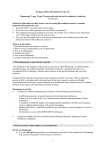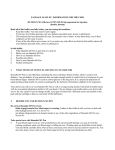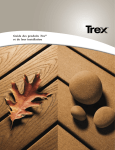Download leaflet MAH BRAND_PL 00006-0300
Transcript
PAMAQ046UKF PACKAGE LEAFLET: INFORMATION FOR THE USER Humatrope® 6 mg/ 12 mg/ 24 mg powder and solvent for solution for injection Somatropin Read all of this leaflet carefully before you start using this medicine. • Keep this leaflet. You may need to read it again. • If you have any further questions, ask your doctor or pharmacist. • This medicine has been prescribed for you. Do not pass it on to others. It may harm them, even if their symptoms are the same as yours. • If any of the side effects gets serious, or if you notice any side effects not listed in this leaflet, please tell your doctor or pharmacist. In this leaflet: 1.What Humatrope is and what it is used for 4. Possible side effects 2.Before you use Humatrope 5. How to store Humatrope 3.How to use Humatrope 6. Further information 1. WHAT HUMATROPE IS AND WHAT IT IS USED FOR Your medicine or the medicine of the person in your care is called Humatrope. It contains human growth hormone, also called somatropin. Humatrope is made by a special process known as recombinant DNA technology. It has the same structure as the growth hormone that your body produces. Growth hormone regulates the growth and development of cells in your body. When it stimulates growth of cells in the spine and in the long bones of the legs, it causes an increase in height. In growth hormone deficiency, growth hormone also increases the bone mineral content, the number and size of the muscle cells and reduces the body fat stores. HUMATROPE IS USED FOR • Treatment of children and adolescents with any of the following growth disorders: - Insufficient production of growth hormone (Growth hormone deficiency), - Absence of all or some of the X-sex chromosomes in females with short stature (Turner syndrome), - A condition in which the kidneys are damaged (chronic problems with the way the kidneys work) in children before puberty - Small at birth (SGA = Small for gestational age) with failure to catch-up height by 4 years of age or later, - Analterationtoagene calledSHOX(SHOX deficiency). • Treatment of adults who have confirmed growth hormone deficiency beginning in either childhood or adulthood. 2. BEFORE YOU USE HUMATROPE DO NOT use Humatrope if you: • are allergic (hypersensitive) to somatropin or any of the other ingredients of Humatrope (e.g. metacresol, glycerol in the solvent) see Section 6. • currently have a brain tumour or any form of cancer. Tumours must be inactive and anti-tumour therapy completed before starting growth hormone therapy. • h ave already stopped growing and want to promote further growth in height (closed growth plates at the end of long bones). Your doctor will examine you to decide if you still require Humatrope after your bones have stopped growing. • are very ill and require intensive medical care for a serious heart or abdominal operation, being treated for multiple injuries from an accident, or require mechanical breathing treatment following acute lung failure. Take special care with Humatrope if you: • have been treated for growth hormone deficiency during childhood. Your doctor will re-examine you for growth hormone deficiency to decide if you require further Humatrope treatment during adulthood. • have completed previous anti-tumour therapy; a scan of your brain may be required before the start of Humatrope treatment. You should be examined regularly to make sure that the tumour does not come back or start growing. • had cancer as a child. A higher risk for having a second tumour (benign and malignant) has been reported in patients that survived their cancer and were treated with somatropin. Of these second tumours, in particular, brain tumours were the most common. • have symptoms such as frequent or bad headache, with nausea and/or vision problems occur, tell your doctor immediately. Your doctor should perform an examination of the eyes to look for evidence of increased brain pressure. Depending on the results of this examination, treatment with Humatrope may have to be interrupted. • develop a limp or pain in the hip, please ask your doctor for advice. During periods of growth, you may develop bone disorders in your hips. • start treatment, Humatrope can affect the amount of thyroid hormones in your blood. If the thyroid hormone level is low, it may reduce your response to Humatrope. Therefore, you must have regular thyroid function tests regardless whether you receive thyroid hormone therapy or not. • are a child, make sure that you continue treatment until the end of growth has been reached. • take a higher than prescribed dose of Humatrope. You may experience overgrowth of some parts of your body such as ears, nose, jaw, hands and feet. Overdose may also lead to increased levels of blood sugar and sugar in the urine. Always use Humatrope as recommended by your doctor. • h ave growth disorder due to kidney damage; treatment with Humatrope should be stopped prior to kidney transplantation. • h ave acute critical illness; your treating doctor should be notified. Deaths have been reported in patients receiving somatropin during critical illness. • are growth hormone deficient and also have Prader-Willi syndrome (a genetic disorder). Your doctor should examine you for breathing problems and airway infections before starting Humatrope treatment, especially if you are overweight, have previously experienced severe breathing problems (especially during sleep), or suffered infection of the lungs or airways. If during treatment you have signs of breathing problems (snoring), treatment should be interrupted and the cause assessed by your doctor. • have diabetes mellitus, your doctor will check the amount of sugar in your blood, and may adjust your diabetes therapy. Humatrope may affect the way your body handles sugar from food and drink by interfering with the way your body uses insulin. • have a growth disorder associated with being born small for gestational age. Your blood sugar and insulin levels will be checked before starting the treatment and regularly during treatment. • are elderly (over 65 years), as you may be more sensitive to Humatrope and may be prone to side effects. • are a child and you are treated with somatropin. You have an increased risk of developing an inflammation of your pancreas (pancreatitis) compared to adults treated with somatropin. Although rare, pancreatitis should be considered in somatropin-treated children who develop abdominal pain. Using other medicines Please tell your doctor or pharmacist if you are taking, or have recently taken, any of the following medicines, including those obtained without a prescription: • medicines for the treatment of diabetes mellitus which may have to be adjusted. • adrenal steroid hormone (glucocorticoid), such as cortisone or prednisolone; your doctor may need to adjust the dose because the combination of these medicines with Humatrope may reduce the effect of both treatments. • oestrogen replacement therapy, as it may affect the response to growth hormone treatment. If there is a change to the way oestrogen is taken (e.g. oral to transdermal: through the skin); Humatrope dose may need to be adjusted. • medicines to prevent seizure (anticonvulsants) or cyclosporine. Pregnancy and breast feeding Humatrope should not be used during pregnancy, unless your doctor tells you to do so. If you become pregnant, tell your doctor immediately. It is not known whether somatropin enters the breast milk. If you are breast-feeding, or intend to breast-feed, please ask your doctor for advice before using Humatrope. Driving and using machines Humatrope has no known effect on ability to drive or use machines. Important information about some of the ingredients of Humatrope • H umatrope contains less than 1 mmol per daily dose of sodium, it is therefore considered essentially sodium-free. 3. HOW TO USE HUMATROPE Always take Humatrope exactly as your doctor has told you. You should check with your doctor or pharmacist if you are not sure how to use Humatrope. • Always make sure you use the strength of cartridge your doctor prescribed (either 6 mg, 12 mg or 24 mg strength) and the appropriate CE-marked Humatrope pen injection system. Never use cartridges of other medicines in your Humatrope pen. • Each cartridge of Humatrope comes with a syringe containing a diluent (solvent for solution for injection) for reconstitution (mixing and preparing of the injection solution). • You must not mix or inject Humatrope until you have received appropriate training from your doctor or other qualified health care professionals. • For detailed instructions on how prepare and inject Humatrope, please see Section “How to inject Humatrope” at the end of this leaflet. You must only mix Humatrope with the diluent provided. Never mix it with anything else unless your doctor tells you to. • After reconstitution, Humatrope should be injected into the fat tissue just beneath the skin using a short needle and a pen injection system. • The injection sites should be varied in order to avoid local reduction and hardening of the fat tissue under the skin (lipoatrophy). • After mixing Humatrope, do not leave it out of the refrigerator for longer than 30 minutes each day. • Keep your pen with the rest of the Humatrope in the fridge. Do not use any Humatrope left over in the pen after 28 days of mixing. Dosage Your doctor will advise you on your dosage and administration schedule. Do not change your dosage without talking to your doctor. Usually, treatment with Humatrope is a long term treatment; your doctor may need to adjust your dose over time depending on your body weight and response to treatment. In general, the dose is calculated according to the following recommendations and administered once daily: Children and adolescents with: • Growth hormone deficiency: 0.025–0.035 mg/kg body weight daily, • Turner syndrome: 0.045–0.050 mg/kg body weight daily, • Chronic problems with the way the kidneys work: 0.045–0.050 mg/kg body weight daily, • Small for gestational age at birth: 0.035 mg/kg body weight daily. Treatment should be discontinued after the first year of treatment if the growth rate is insufficient, • SHOX gene deficiency: 0.045-0.050 mg/kg body weight daily. Growth hormone deficiency in adults: Treatment should be started with a low dose of 0.15–0.30 mg daily. Lower starting doses may be required in older and overweight patients. The starting dose may be increased gradually according to your individual requirements. Total daily dose usually does not exceed 1 mg. Dose requirements may decline with increasing age. Women, especially those on oral oestrogen replacement, may require higher doses than men. If you use more Humatrope than you should If you have injected more Humatrope than you should have, please ask your doctor for advice. • If you have injected too much Humatrope, initially your blood sugar may decrease and become too low (hypoglycaemia) and subsequently increase and become too high (hyperglycaemia). • If you inject too much Humatrope over a longer period (years), you may experience overgrowth of some parts of your body such as ears, nose, jaw, hands and feet (acromegaly). If you forget to use Humatrope Do not inject a double dose to make up for a forgotten dose. Continue with the prescribed dosage. If you forget to inject Humatrope and have any doubts about what to do, please contact your doctor. If you stop using Humatrope Please ask your doctor for advice before stopping treatment. Interruption or early stopping of treatment with Humatrope may impair the success of the Humatrope treatment. 4. POSSIBLE SIDE EFFECTS Like all medicines, Humatrope can cause side effects, although not everybody gets them. You may experience any of the following side effects after injecting Humatrope: The following convention has been used for the classification of the adverse reactions: Very common side effects may happen in more than 1 in 10 patients Common side effects may happen in 1 in 100 to 1 in 10 patients Uncommon side effects may happen in 1 in 1,000 to 1 in 100 patients Rare side effects may happen in 1 in 10,000 to 1 in 1,000 patients Very rare side effects may happen in fewer than 1 in 10,000 patients, including isolated reports Common Injection site pain Swelling (Oedema) Uncommon Children Weakness Bad or frequent headaches with nausea and/or vision problems are signs of increased brain pressure (benign intracranial hypertension). Tell your doctor immediately if this happens. High blood sugar (hyperglycaemia) Hypersensitivity to metacresol or/and glycerol Low levels of thyroid hormone Numbness and tingling (paresthesia) Development of antigrowth hormone antibodies Very common Headache Joint pain (arthralgia) Rare Very rare Difficulties sleeping (insomnia) High blood pressure (hypertension) Breast enlargement (gynaecomastia) Sugar in urine (glucosuria) Localised muscle pain (myalgia) Common Adults Uncommon Injection site pain Weakness Swelling (Oedema) Breast enlargement (gynaecomastia) High blood sugar (hyperglycaemia) Hypersensitivity to metacresol or/and glycerol Low levels of thyroid hormone Difficulties sleeping (insomnia) Numbness and tingling (paresthesia) Numbness and tingling in fingers and palm of the hand due to squeezed nerve at hand wrist (carpal tunnel syndrome) Localised muscle pain (myalgia) High blood pressure (hypertension) Shortness of breath (Dyspnea) Temporary interruption of breathing during sleep (Sleep Apnea) Rare Bad or frequent headaches with nausea and/or vision problems are signs of increased brain pressure (benign intracranial hypertension). Tell your doctor immediately if this happens. Sugar in urine (glucosuria) The effect of insulin may be reduced. Leukaemia has been reported in a small number of children who have been treated with growth hormone. However there is no proof that leukaemia occurrence is elevated in patients receiving growth hormone. If any of the side effects get serious, or if you notice any side effects not listed in this leaflet, please tell your doctor or pharmacist. The following steps will guide you to prepare your new cartridge for use 5. HOW TO STORE HUMATROPE - Keep out of the reach and sight of children. - D o not use after the expiry date stated on the label and carton. The expiry date (EXP) refers to the last day of the month indicated. - Do not use Humatrope if you notice that the solution is cloudy or has any particles in it. - Always store Humatrope in a refrigerator (2°C – 8°C). Do not freeze. - After mixing Humatrope, do not leave it out of the refrigerator for longer than 30 minutes each day. - Humatrope can be used for up to 28 days after mixing if you keep it in the fridge for no longer than 30 minutes each day at room temperature. - Medicines should not be disposed of via waste water or household waste. Ask your pharmacist how to dispose of medicines that are no longer required. These measures will help to protect the environment. Step 1 Unpacking 1a 1b Sterile Diluent Syringe The pre-filled solvent syringe contains: glycerol, metacresol, water for injection. [Hydrochloric acid or sodium hydroxide (or both) may have been used in the manufacturing process to adjust acidity]. What Humatrope looks like and contents of the pack • 1 cartridge with white powder for solution for injection, Humatrope 6 mg: • 3.17 ml of clear colourless solvent solution in a pre-filled syringe Pack size of 1, 5 and 10 Humatrope 12 mg: Humatrope 24 mg: 2 • 1 cartridge with white powder for solution for injection, • 3.15 ml of clear colourless solvent solution in a pre-filled syringe. Pack size of 1, 5 and 10 Needle cover Remove Needle Cover and discard. DO NOT depress Plunger yet. It is okay if a drop of fluid is lost. It is not necessary to release air from the Diluent Syringe. With thumb OFF the plunger, pull the cartridge from the Diluent Syringe. This medicinal product is authorised in the Member States of the EEA under the following names: In member states of the EEA where this medicinal product is authorized, it is authorized under the name “Humatrope”, except in France where it is authorized under “Umatrope”. How to inject Humatrope 6 mg/ 12 mg/ 24 mg Hold cartridge, Black Triangles up. Align the cartridge and Diluent Syringe in a straight line. DO NOT insert the cartridge at an angle. Place the End Cap on a hard, flat surface. Push the Diluent Syringe onto the End Cap and immediately discard the Diluent Syringe as instructed by your healthcare professional. Step 7 Gently Mix - M ix the solution by gently rotating the cartridge 10 times. DO NOT SHAKE THE CARTRIDGE. Let the cartridge sit for 3 minutes, then inspect the solution carefully. - If the solution is cloudy or contains particles, gently mix the cartridge another 10 times. Let the cartridge sit for 5 more minutes. If the solution remains cloudy or contains particles DO NOT USE THE CARTRIDGE. 7b 7a 3 Black Triangles Manufacturer Lilly France Rue du Colonel Lilly F-67640 Fegersheim France For any information about this medicine, please contact the Marketing Authorisation Holder (or the local representative): Eli Lilly and Company Limited, Lilly House, Priestley Road, Basingstoke, Hampshire, RG24 9NL, United Kingdom. Phone: +44 (0) 1256 315999 x 10 PUSH the cartridge STRAIGHT in until it stops AND the Black Triangles ARE COVERED. You may hear or feel a click. Do not twist the cartridge. Inspect the solution. The Humatrope® solution should be clear. Step 8 Injecting Humatrope using a suitable pen injection system - - - - - - - I f the solution is clear, your cartridge is now ready to be attached to the suitable Humatrope pen. Put the cartridge in the pen (see the user manual for the pen) Always use a new sterile needle for each injection Wipe the skin thoroughly with an alcohol swab. Let the skin dry. Set the correct dose (see the user manual of the pen) Inject slowly under the skin (subcutaneous) in the way you have been taught by your doctor. Remove the needle from the skin and safely dispose of the needle, as you have been shown by your doctor or health care professional. - Keep your pen with the rest of the Humatrope in the fridge. Do not use any Humatrope left over in the pen after 28 days of mixing. Step 4 Mixing Humatrope The following instructions explain how to inject Humatrope. Please read the instructions carefully and follow them step by step. Parts Getting started: Plunger 4a 4b Humatrope is a trademark of Eli Lilly and Company Limited This leaflet was last approved in January 2011. Black Triangles Diluent Syringe Diluent* Only use parts from this kit to prepare the drug cartridge. Needle cover Gently mix the cartridge 10 times and let sit for 3 minutes, DO NOT SHAKE. Not all pack sizes may be available in your country You will require five items: 1.Humatrope cartridge of the correct strength 2.A syringe filled with diluent 3.A CE-marked Humatrope pen 4.A sterile pen needle, and 5.An alcohol swab Wash your hands before you continue with the next steps Plunger Step 2&3 Connecting the cartridge • 1 cartridge with white powder for solution for injection, • 3.15 ml of clear colourless solvent solution in a pre-filled syringe Pack size of 1, 5 and 10 Marketing Authorisation Holder Eli Lilly and Company Limited Lilly House Priestley Road, Basingstoke Hampshire, RG24 9NL United Kingdom 1c Plunger Grasp Needle Cover, which is at the bottom of the Diluent Syringe. Remove ALL contents from the tray. Note: This product is designed for left or right handed use. Please feel free to use whichever hand is most comfortable for you. 6 5 • Y ou must only mix Humatrope with the diluent provided. Never mix it with anything else unless your doctor tells you to. • Please read the user manual that comes with your pen. This will remind you what you have been taught by your doctor or health care professional. • Please follow the instruction underneath the diagrams 6. FURTHER INFORMATION What Humatrope contains Powder in a cartridge The active substance is somatropin. Each cartridge contains 6 mg, 12 mg or 24 mg depending on the strength. When reconstituted: • Humatrope 6 mg gives 1.9 mg somatropin per ml solution • Humatrope 12 mg gives 3.8 mg somatropin per ml solution • Humatrope 24 mg gives 7.6 mg somatropin per ml solution The above mentioned concentrations after reconstitution are theoretical values. The other ingredients are: mannitol, glycine, dibasic sodium phosphate. [Phosphoric acid or sodium hydroxide (or both) may have been used in the manufacturing process to adjust acidity]. Step 5&6 Release Cartridge and Discard Diluent Needle Cover Humatrope® Cartridge White Tip End Cap *Note: The liquid is colourless. It is shown here as blue for illustration purposes only. Hold the Diluent Syringe and the cartridge together with TWO HANDS. Push and release the Plunger 2 or 3 times until the Diluent is in the cartridge. Remove thumb from the Plunger and check that the Diluent Syringe is empty (it is normal for small drops of Diluent to remain in the Diluent Syringe). PAMAQ046UKF










![[Product Monograph Template - Standard]](http://vs1.manualzilla.com/store/data/005786637_1-bbde87d0b5b85ef8c8ff6a7fd943fd08-150x150.png)


